#1900 Sewing Machine
Explore tagged Tumblr posts
Text
youtube
FC-1900BMP: Bar Tack, Button Sewer and 100 Pattern Sewing Multi Purpose Sewing Machine For Details Call on +91 9811002015
#Bar Tack#Bar Tacking#Button Sewer#Button Sewing#Button Stitching#Button Sewing Machine#Button Stitching Machine#Pattern Sewing Machine#Pattern Stitching Machine#Industrial Sewing Machine#Fucen Sewing Machine#Fucen Industrial Sewing Machine#Bar Tack Sewing Machine#Bartack Sewing Machine#Fucen Bartack Sewing Machine#100 Patterns Stitching Machine#FC-1900BMP#FC-1900BMP Sewing Machine#1900 Sewing Machine#Youtube
0 notes
Text

#singer sewing machine#wallpaper#lm montgomery#leaskdale#manse#window#1900’s#film photography#personal
61 notes
·
View notes
Text

I recently added this lovely Daisy sewing machine from before the nineteen-teens to my collection. She has all of her working parts, and she sews nicely. Welcome home, Daisy!
#sewing machine#antique sewing machine#vintage sewing machine#antique#vintage#crafts#crafting#artists on tumblr#sewing#sewists of tumblr#daisy#1910s#1900s#grandmacore#cottagecore#sewing machines
87 notes
·
View notes
Text

Singer Sewing Machine ad from the Pan Am Expo in Buffalo, New York, 1901
79 notes
·
View notes
Text



everyone look at the cute dead mid Victorian couple and my new beauty up and running
#the locket is probably gold filled by the luster#Victorian#Victorian era#mid Victorian#the sewing machine is 1930s electric but the table is 1890s-1900s
7 notes
·
View notes
Text
Kitten I'm going to be honest with you daddy's about to Niccori kori kill themself

#This post brought to you by my absolute exhaustion at sewing#if my fabric puckers inconveniently ONE MORE TIME#I'm going to treat my sewing machine like a 1900s housewife that didn't make me dinner before I got home from work
2 notes
·
View notes
Text
An Incredible Find
This week Delayne used her knowledge of art history to identify a beautiful machine inherited when a beloved local store closed its doors after nearly 100 years. Read "An Incredible Find" to find out more #MarywoodArt #ArtHistory #ArtsAdministration

View On WordPress
#1900s#1920s#Art#art deco#Art History#art nouveau#bridal#embellishments#Geometric#History#International Sewing Machine Collectors&039; Society#Marywood Art Department#Marywood University#Marywood University Art Department#preservation#sewing#Singer Sewing Machine#Sullums#Where Creativity Works
3 notes
·
View notes
Text
First sewing project of 2025 completed!

It's a Vicwardian shirtdress that kind of straddles the lines between historybounding and historical costuming and cosplay.
See, I have made 3-4 blouses/shirtwaists in this style now, and the most irritating thing about them is that they gradually get more and more untucked throughout the day until I'm left with a muffin top spilling over my skirts. So I figured, why not make one that's the bodice of a dress? That way, I can anchor the blouse part down to the waistband so it can't ride up and come untucked, and I can control how much it's allowed to blouse and keep it that way 24/7 since it's stitched down.


^See? Now I won't have to constantly adjust and re-adjust the gathering and pleating into the waistband or tug my shirttails down because I can feel the back of the blouse ballooning out again.
(Almost forgot to mention: yes, the skirt has giant Victorian-style pockets in the side seams. The dress was 99% hand sewn, mostly because I was working on it while out of town without access to my machine, but also because when I got home and tried to attach a facing to the pockets, my machine decided 3 layers of this shirting-weight cotton twill fabric was too much to handle and broke down. So thanks for that, pockets. Now I have to find a repair shop or replacement machine.)
And bonus: the skirt can be worn as is, or it can function as a petticoat under a separate skirt I can wear over the dress. If I make a floor-length walking skirt to wear over this shirtdress, and maybe a waistcoat and/or an Eton jacket, then I'll have a convincing enough 1890s-1900s ensemble for historical costuming purposes.

Oh, and in case you can't tell, the bodice design with the diagonal pintucks in the yoke is inspired by the outfit that Elphaba wears in her "The Wizard and I" sequence from the new movie. She wears this gauzy, crinkle chiffon-looking blouse under a black jumper dress, and the visible parts of the blouse look like they're bias cut, with some kind of pintucked or micro-pleated texture.
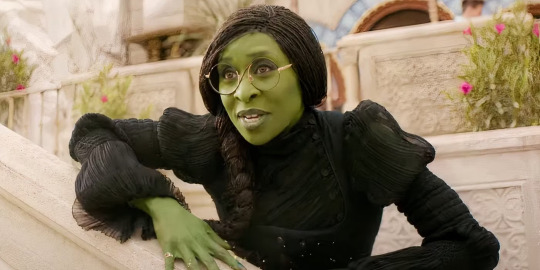
I basically spent the last month and change drooling over the costuming and wanting Elphaba's entire wardrobe. I don't think I'll be accurately recreating any of her actual costumes, but I like to think that my new shirtdress *could* potentially be something she'd wear.

Oh, and here's a detail of the lower sleeves on my dress. Elphaba's usually wearing all black, so the movie costumers played a lot with the texture of the fabrics on her clothing. They were inspired by mushrooms and other earthy textures, so her dresses have a more organic look than what I have going on here. I didn't have enough fabric to play around with, so I figured I'd just give honeycomb smocking a try, and I'm shocked at how well these sleeves preserve body heat in the winter.
Now all I need to do is make her hat and maybe sew a cloth facemask from green fabric and my 2025 office-appropriate Halloween costume will be good to go.
#sewing#hand sewing#historybounding#historical costuming#cosplay#wicked#tricia sews (kind of)#i'm calling this my first project of 2025 but it's actually my last project of 2024. i just didn't finish in time for the new year
201 notes
·
View notes
Text
Writing Notes: Fashion History

for your next poem/story (pt. 1/2)
1850-1879
The Civil War began in 1861 and ended in 1865, heavily impacting the lives of those living during the time period. In fashion, the rise of the sewing machine allowed more decorative effects to be used in dress, and new aniline dyes paved the way for brighter shades of dress.
This time is known as the Crinoline Period because cage crinoline made of whalebone or steel hoops replaced heavy layers of petticoats, and were commonly worn under dresses by women of the time.
One trend that hit its peak in the 1870s was the bustle, an item women secured under the back portion of their skirts to add volume.
In terms of silhouette, a narrow waist with a fitted bodice and full skirts was the recurrent style. Popular sleeve styles included pagoda sleeves, gathered bishop sleeves, and the coat sleeve.
During the day, high necklines were appropriate, but women often wore lower necklines in the evening.
Wraps and shawls were commonly worn, and accessories such as parasols, gloves, snoods, and bonnets were highly desired.
1870-1900
The years 1870-1900 include what is known as the Bustle period, in which the popular silhouette shifted from full skirts to a more fitted look characterized by fullness in the back.
Throughout the Bustle period of the 1870s and 1880s, a variety of padded devices were utilized to create back fullness, as the bustle took on different forms.
The bustle of the first stage (1870-1878) was achieved through manipulation of drapery and the use of decorative details such as flounces and bows at the back.
From (1878-1883) fullness dropped to below the hips and decorative effects of the skirt became focused low as a result.
Long trains and heavy fabrics also helped to emphasize the focus on the rear.
The latter part of the decade (1884-1890) saw the bustle at its largest. Often referred to as the shelf bustle, it was rigid and took on the appearance of an almost horizontal projection. At this time, skirts shortened to several inches above the floor and rarely had trains, with the exception of some evening dresses.
Additionally, they include the 1890's, which are often referred to as the Gay Nineties or La Belle Epoque. Times were good, Paris was the center of high fashion, and for those who could afford it, dress was lavish and highly decorative.
The corset continued to be worn, aligning with the fashionable silhouette of a full bust and hips with a narrow waist.
Dress ensembles typically consisted of two pieces -- a bodice and matching skirt.
The one-piece princess dress, worn by some during the latter part of the period, was an exception. Bodices were often fitted, with the cuirass bodice style emerging from around 1878-1883.
Sleeves were close-fitting and ended at either three quarters or at the wrist.
Evening dresses were differentiated by their lavish trimmings, level of ornamentation, trained skirts, and short sleeves. Weighted silk offered greater body and was a popular choice for dresses beginning in the 1870s.
Full sleeves were at their largest in 1895, before they gradually decreased in size towards the turn of the century.
By the 1890s, sleeve with fullness were only seen with small puffs at the shoulders.
Tailor-made costumes consisted of wool or serge skirts worn with a shirtwaist blouse. and were considered ideal for traveling.
Shirtwaist blouses were often accessorized by cravats and jabots. The variety of outerwear for women increased during the late nineteenth century and was dominated by coats, jackets, and wraps.
Accessories of the period included small hats, gloves, muffs, decorative fans, and parasols.
1900s
The first decade of the twentieth century is often referred to as “La Belle Époque” - French for "the beautiful age." During this time, Paris reigned as the capital of art and fashion, extravagance and opulence was in, and French couture became all the rage.
Edward VII became King of England with the death of Queen Victoria in 1901, ushering in the “Edwardian Era.”
Additionally, Henry Ford's Model-T was introduced in 1908.
Art Nouveau influenced fashion and ornamentation with the popularity of curvy shapes, floral prints, and ornamentation.
And with the introduction of Ford's Model-T, "motoring garments", such as duster coats and goggles, became essential for automobile riding.
The dominant silhouette of the period was the S-bend hourglass shape, which was achieved through the use of long bell or trumpet skirts that swept the ground, and the “monobosom” fullness of the front bodice.
Voluminous sleeves were another popular feature of turn-of-the-century fashion. Women still wore tightly-boned corsets, along with layers of petticoats. Two-piece ensembles were introduced, consisting of a skirt and a shirtwaist blouse. Garments often featured necklines with high standing collars for daytime and exceptionally low décolleté necklines for evening wear.
Lingerie dresses — flowing white gowns with lace detailing — were a popular choice for outdoor hot weather. Pale colors and un-patterned fabrics adorned with lace or embroidery were favored in this style. Shoes and boots exhibited pointed toes, and parasols were a must-have accessory for outdoors. Elaborate, often large hats decorated with bird feathers enjoyed heightened popularity.
1910s
The War Years (1914-1918) resulted in simpler styles, with moderation in fabric usage as well as the use of darker hues. As a result, garments of this period often have a more utilitarian and masculine appearence.
The “teens,” as the 1910s are often referred to, saw sweeping changes in fashion due to the work of French designer Paul Poiret, who was largely inspired by both the exoticism and color of the Far East and the Ballet Russes. “Orientalism” in fashion became all the rage and was seen in kimono-shaped coats, capes, saturated colors, and exotic embellishments.
Popular trends included the “peg-top” silhouette with hip fullness, Paul Poiret’s narrow-at-ankle “hobble skirt”, and Mariano Fortuny’s “Delphos gown” which featured his secret pleating technique.
Tunic dresses were also introduced, and featured a short skirt layered over a longer one. Necessitated by the new shapes in fashion, the hourglass S-bend silhouette transitioned into a more column-like, tubular form with a higher waistline. Brassieres replaced tight corsets and accommodated the soft, unfitted tea gown, a popular choice for afternoon hosting. The wide-brim hat continued to be a fashionable accessory and shoes began to replace boots.
1920s
The year 1920 marked the beginning of Prohibition, as well as the end of the Suffrage Movement, with women gaining the right to vote.
King Tutankhamen’s tomb was discovered in 1922, further fueling the taste for the exotic, and creating an obsession with all things Egyptian.
The Harlem Renaissance ushered in the Jazz Age; sleeveless dresses with shorter hemlines and sequin, bead, and fringe embellishment enhanced and enabled the fast-paced dance movements of the Charleston and Fox Trot.
The "Roaring Twenties" were years of major change for both fashion and society.
Besides major cultural events inspiring change, fashion was also influenced by Art Deco through the use of straight lines and geometric forms in both silhouette and decoration. The twenties silhouette was straight and tubular, and dresses deemphasized female curves, breasts, and hips.
Chemise dresses hung straight from the body and helped created this fashionable linear silhouette. The “flapper,” with her bobbed-hair and boyish silhouette, became the epitome of the fashionable look of the period. Hemlines rose, revealing more of the female leg for the first time in dress history, and shifting the focus to shoes for the first time.
During the period, Gabrielle “Coco” Chanel popularized costume jewelry — as well as wool jersey suits.
The cloche, a bell-shaped hat, was “the” hat to have.
Small beaded purses and long beaded necklaces were popular accessories.
1930s
The defining event of the 1930s was the Great Depression.
The stock market crash of 1929 and the ensuing depression created a need for less expensive garments without elaborate ornamentation. Designers of the period therefore relied on seam lines and darts as major forms of embellishment. Clothing that was cheaper and diversified was critical, thus creating the need for ready-to-wear fashion.
The overwhelming popularity of the movies in the 1930s helped perpetuate the ideals of “Hollywood glamour.” Women began looking to screen stars for inspiration in fashion, hairstyles, makeup, and even demeanor. The movies, and the glamorous lifestyle they portrayed, were a way for the public to escape the harsh realities of the Depression.
Designers such as Elsa Schiaparelli incorporated concepts of Surrealist Art into fashion designs, offering fantastical creations that also provided a flight from reality.
The 1930s also saw the birth of American sportswear and two-piece bathing suits for women. The decade saw a continuation of the linear shape of the 1920s, but with a leaner, longer, more feminine silhouette. The waistline returned to its natural position and hemlines dropped. Evening fabrics tended to be pale or white solids of silk or satin, and the backless evening gown was introduced at this time.
French designer Madeleine Vionnet created the “Bias Cut”, which produced a “liquid” clinging effect on the body. Hats of all varieties were widely worn, and a right-angle tilt was a common way hats were styled. Shoes featured low heels and rounded toes. Costume jewelry and fur added the final touch of fashionable glamor.
1940s
World War II began in 1939, ushering in a new conservatism in fashion. Fashion designers were forced to close their houses in Paris, and “practicality” became the new buzzword in fashion, with a focus on producing sensible styles and “utility garments” which required a minimum quantity of fabric.
In the United States, the L-85 Limiting Order aimed to freeze the war-time silhouette and stop rapid seasonal changes in styles in order to conserve fabric use. Tailored suits and military-influenced styles were seen in items such as belts, breast pockets, high necklines, and small collars. Both clothing and hair were influenced by the war.
For women who worked in factories, superfluous decoration and long hair posed safety threats. Hairstyles and makeup became an integral way to achieve personal style, since clothing and accessories were rationed.
Hollywood stars such as Veronica Lake, Rita Hayworth, and Bette Davis were significant influencers of fashion. American designers began developing sportswear collections, spurred by the necessity of the war-time focus on the ideals of simplicity and utility.
Casual separates, shirtwaist dresses, slim skirts with patch pockets, and halter and square necklines became popular. Women could also be seen wearing trousers, although it was mainly for utilitarian purposes, not everyday wear.
The 1940s silhouette was tailored and narrow, with a nipped-in waistline and squared shoulders achieved through the use of shoulder pads. Hemlines rose to just below the knee. In light of rationed fashion, hats allowed an individual fashion statement, and small styles such as veiled pillboxes and berets, often worn at a right angle, were most popular. Shoes were usually chunky with rounded toes and featured either low-heeled or wedge soles.
Leg makeup was also introduced and offered women a remedy to the rationing of nylon stockings.
More Notes: On Fashion ⚜ Writing Notes & References
#writing notes#fashion history#writeblr#worldbuilding#spilled ink#dark academia#writing reference#fashion#literature#writers on tumblr#writing prompt#poetry#poets on tumblr#creative writing#writing inspo#writing inspiration#writing ideas#fiction#writing resources
155 notes
·
View notes
Text
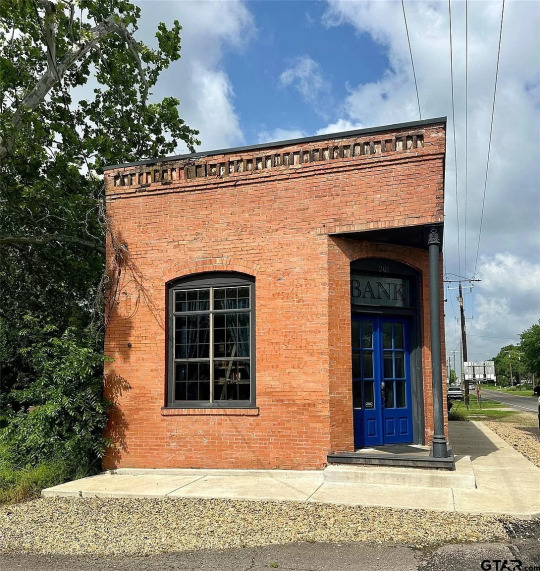
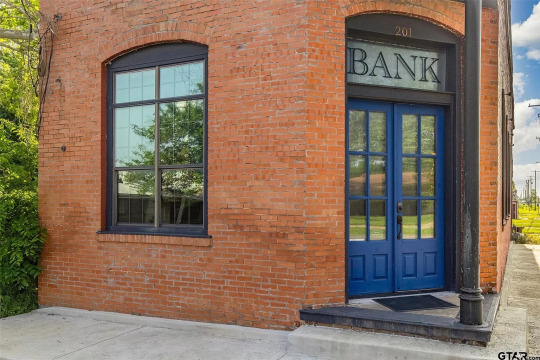
Well, here's a bank conversion finally done right. The bank was built in 1900 in Cumby, TX, (about an hr. from Dallas) has 2bds, 2ba, & is listed for $275K.
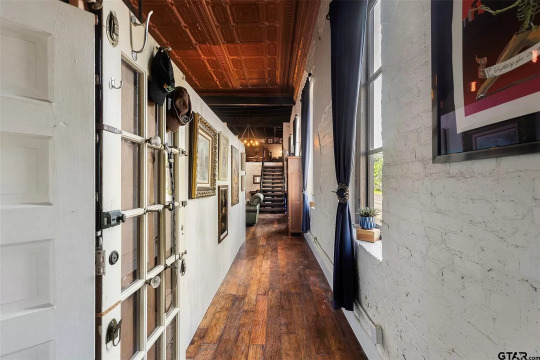
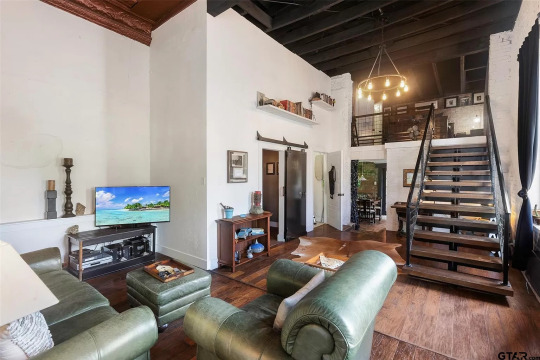
They made a hallway to accommodate a wall to build more rooms. Then down the hall, you come to this lovely open living room.
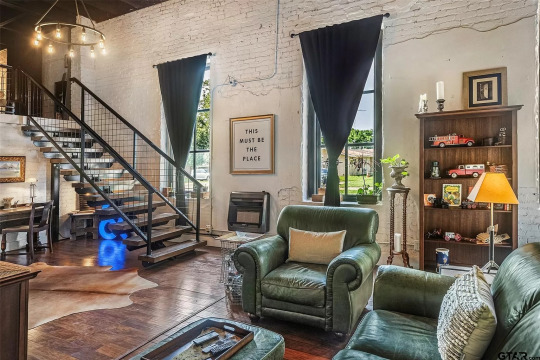
I like the old brick walls. I guess they painted them white to brighten the home.
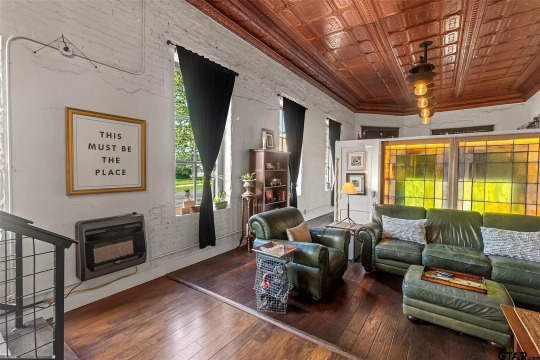
Very nice- the windows look like they could be architectural salvage. Love the ceiling.
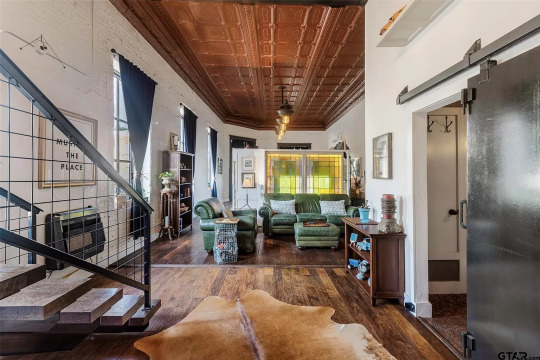
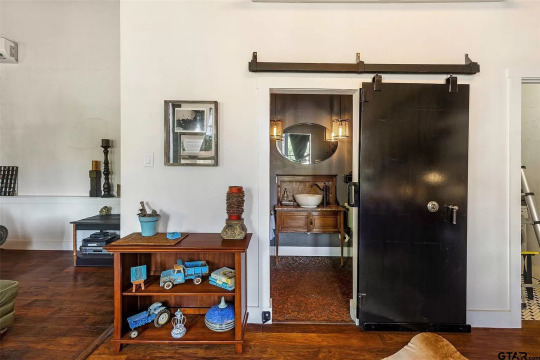
I like the industrial sliding door made out of the original vault door.
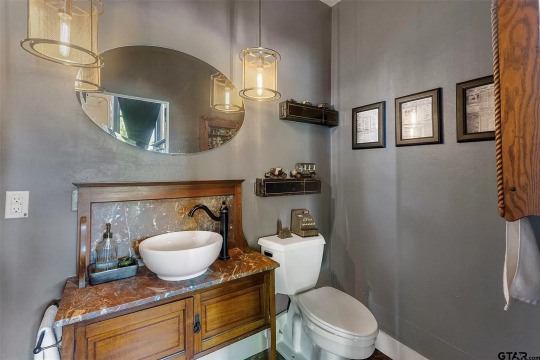
It's possible that this cute vintage bath was the vault.
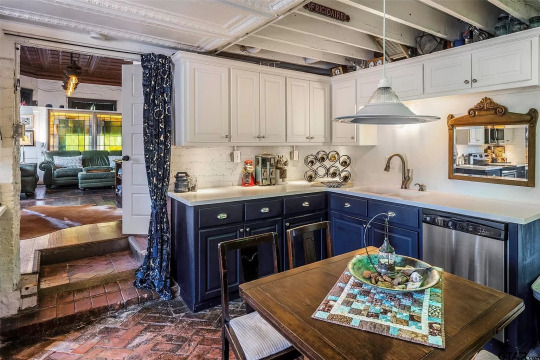
A couple of steps go down to the kitchen. This is adorable.
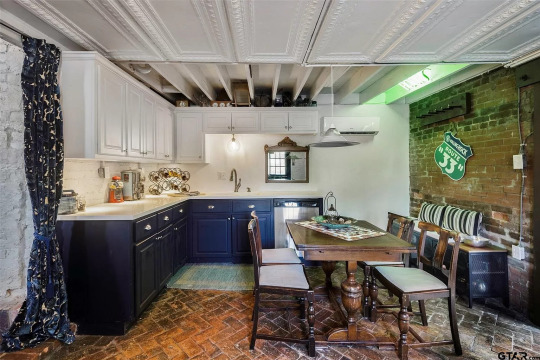
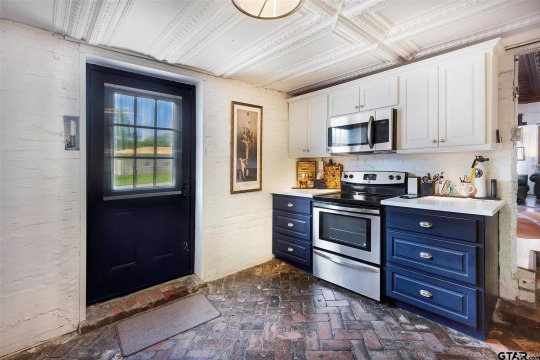
Love th vintage look, blue & white two-tone cabinets, and the exposed brick wall. The kitchen has a door to the outside.
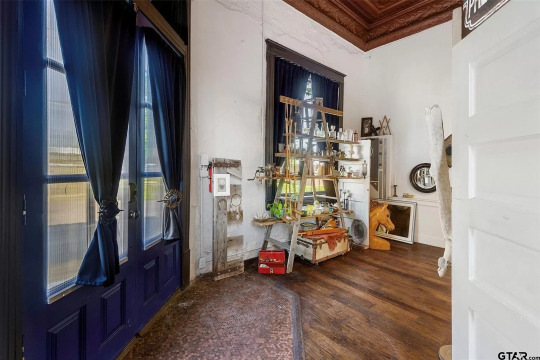
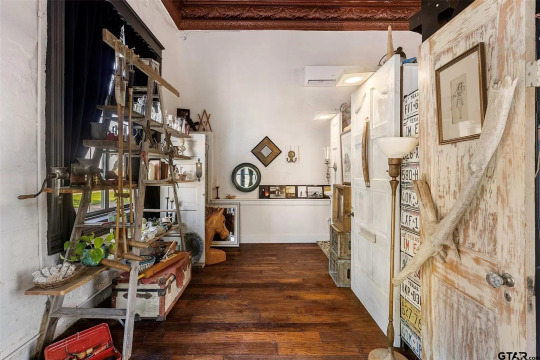
This room would make a great studio or craft space. It could be a man cave or a lady lair, too. Cute flex space.
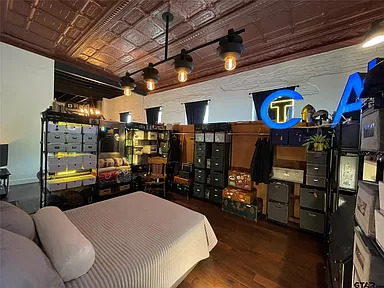
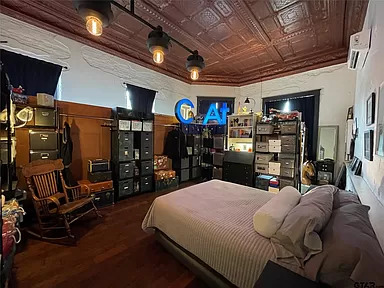
This bedroom is on the other side of the hallway wall.
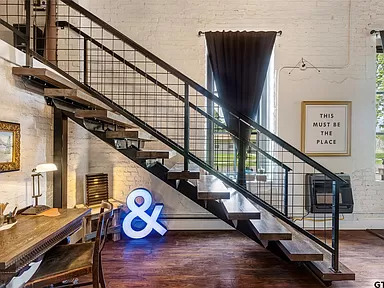
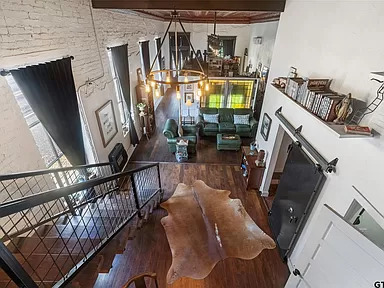
Looking down at first floor.
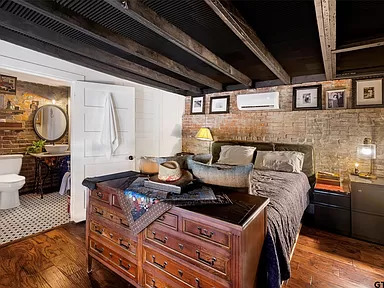
Upstairs is the primary bedroom. Lovely brick wall and beamed ceiling.
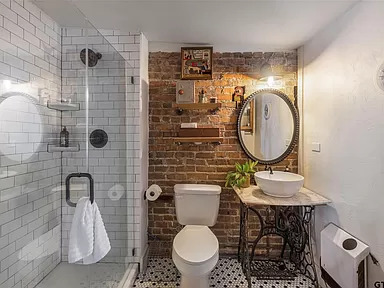
It has a beautiful double shower, vintage tile floor, and a sink made from an antique sewing machine base.
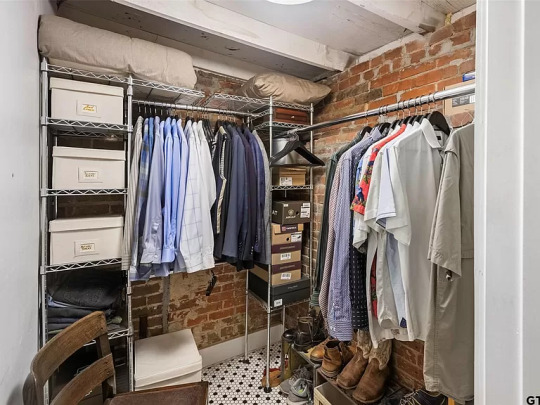
There is also a small walk-in closet.
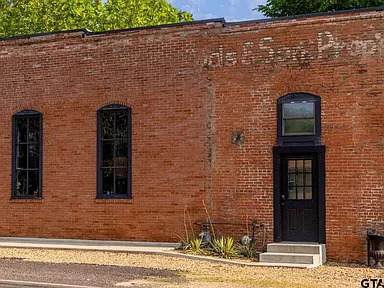
The kitchen door looks like it provides access from the driveway.
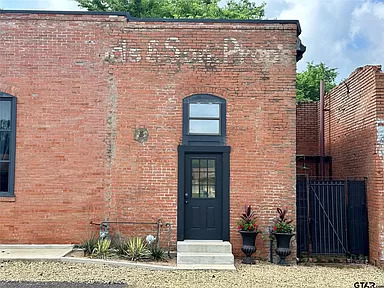
There's a faded sign indicating that there was a business in the building, at one time.
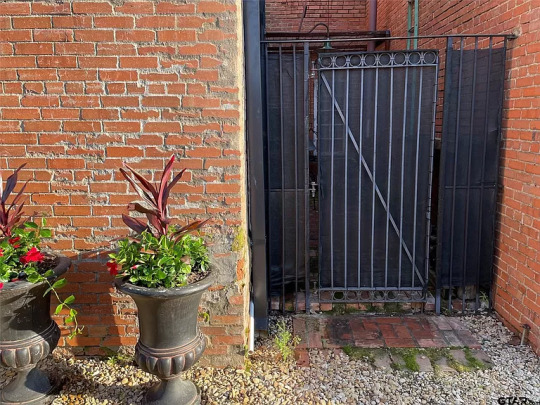
This gate provides privacy.
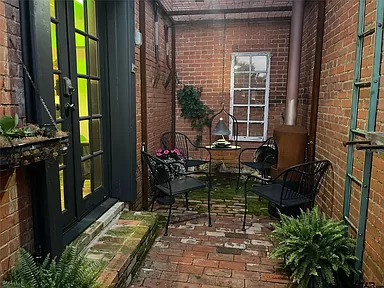
For a small space that makes a great little patio.
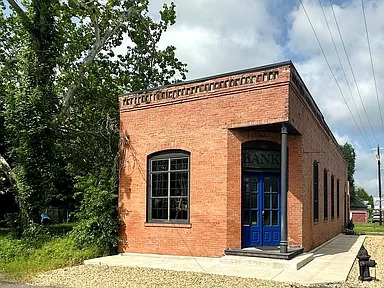
The lot is 1,742 sq ft, so I'm thinking that it must include some of the grassy area along the side.
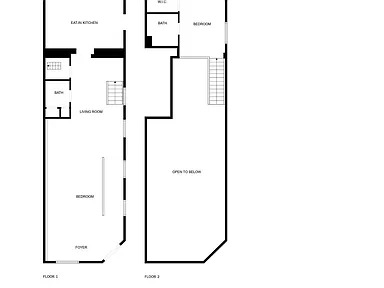
https://www.zillow.com/homedetails/201-W-Main-St-Cumby-TX-75433/243395593_zpid/?
#converted bank#bank conversion#unusual homes#unique homes#houses#house tours#home tour#homes under $300K
333 notes
·
View notes
Text


"Wheeler & Wilson's High-Arm New Number Nine is the only perfect sewing machine for family use." sewing machine advertising card, circa 1870-1900. from digital commonwealth
#check OUT this frog man!!! i have more i'm going to post more#i was doing my regular trawl through public domain stuff and was so charmed by this frog. glad i dug more & found out it was an ad#finds#frog#sewing machines#ephemera#vintage advertising#my uploads
55 notes
·
View notes
Text
We went indoor rock climbing with friends, were late dur to work.
So we took a few minutes to check out the new second hand furniture store near the climbing studio.
And I found a new friend!

It's an old treadle sewing machine from a German manufacturer. This model might be from before 1900.
If I squint I Might have the space for her. And if I'm correct she'll be absolutely breathtaking gorgeous!
And only for 75,-€!!
If I'm brave enough I'll go back tomorrow and ask if she's in working condition, and if I'm allowed to test her
There's also a singer, but I didn't look to closely
91 notes
·
View notes
Text
“By 1900 child mortality was already declining—not because of anything the medical profession had accomplished, but because of general improvements in sanitation and nutrition. Meanwhile the birthrate had dropped to an average of about three and a half; women expected each baby to live and were already taking measures to prevent more than the desired number of pregnancies. From a strictly biological standpoint then, children were beginning to come into their own.
Economic changes too pushed the child into sudden prominence at the turn of the century. Those fabled, pre-industrial children who were "seen, but not heard," were, most of the time, hard at work—weeding, sewing, fetching water and kindling, feeding the animals, watching the baby. Today, a four-year-old who can tie his or her own shoes is impressive. In colonial times, four-year-old girls knitted stockings and mittens and could produce intricate embroidery; at age six they spun wool. A good, industrious little girl was called "Mrs." instead of "Miss" in appreciation of her contribution to the family economy: she was not, strictly speaking, a child.
But when production left the houschold, sweeping away the dozens of chores which had filled the child's day, childhood began to stand out as a distinct and fascinating phase of life. It was as if the late Victorian imagination, still unsettled by Darwin's apes, suddenly looked down and discovered, right at knee-level, the evolutionary missing link. Here was the pristine innocence which adult men romanticized, and of course, here, in miniature, was the future which today's adult men could not hope to enter in person. In the child lay the key to the control of human evolution. Its habits, its pastimes, its companions were no longer trivial matters, but issues of gravest importance to the entire species.
This sudden fascination with the child came at a time in American history when child abuse—in the most literal and physical sense—was becoming an institutional feature of the expanding industrial economy. Near the turn of the century, an estimated 2,250,000 American children under fifteen were full-time laborers—in coal mines, glass factories, textile mills, canning factories, in the cigar industry, and in the homes of the wealthy—in short, wherever cheap and docile labor could be used. There can be no comparison between the conditions of work for a farm child (who was also in most cases a beloved family member) and the conditions of work for industrial child laborers. Four-year-olds worked sixteen-hour days sorting beads or rolling cigars in New York City tenements; five-year-old girls worked the night shift in southern cotton mills.
So long as enough girls can be kept working, and only a few of them faint, the mills are kept going; but when faintings are so many and so frequent that it does not pay to keep going, the mills are closed.
These children grew up hunched and rickety, sometimes blinded by fine work or the intense heat of furnaces, lungs ruined by coal dust or cotton dust—when they grew up at all. Not for them the "century of the child," or childhood in any form:
The golf links lie so near the mill
That almost every day
The laboring children can look out
And see the men at play.
Child labor had its ideological defenders: educational philosophers who extolled the lessons of factory discipline, the Catholic hierarchy which argued that it was a father's patriarchal right to dispose of his children's labor, and of course the mill owners themselves. But for the reform-oriented, middle-class citizen the spectacle of machines tearing at baby flesh, of factories sucking in files of hunched-over children each morning, inspired not only public indignation, but a kind of personal horror. Here was the ultimate "rationalization" contained in the logic of the Market: all members of the family reduced alike to wage slavery, all human relations, including the most ancient and intimate, dissolved in the cash nexus. Who could refute the logic of it? There was no rationale (within the terms of the Market) for supporting idle, dependent children. There were no ties of economic self-interest to preserve the family. Child labor represented a long step toward that ultimate "anti-utopia" which always seemed to be germinating in capitalist development: a world engorged by the Market, a world without love.”
-Barbara Ehrenreich and Deirdre English, For Her Own Good: 150 Years of the Experts’ Advice to Women
536 notes
·
View notes
Text
☆Update 2:☆
I remembered to take pics today! Sort of. Only after i had put away my machines and stuff...
Here are (most) of my edwardian undergarments
(i am wearing modern clothes under bcs the internet is weird)
Chemise, bustle pad, underbust corset, petticoat
I still need to make a corset cover someday, ive just been using a second thin chemise over all this:
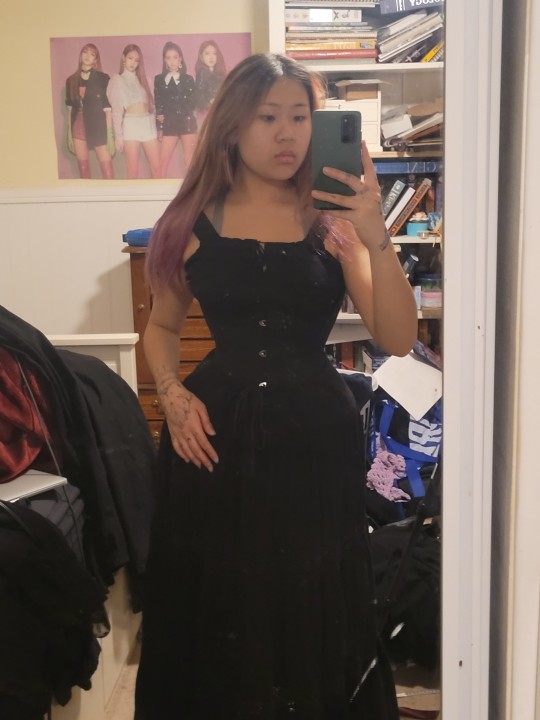
I used these vintage buttons on the cuffs. I wanted some more security but ran out of buttons so i used small snaps:
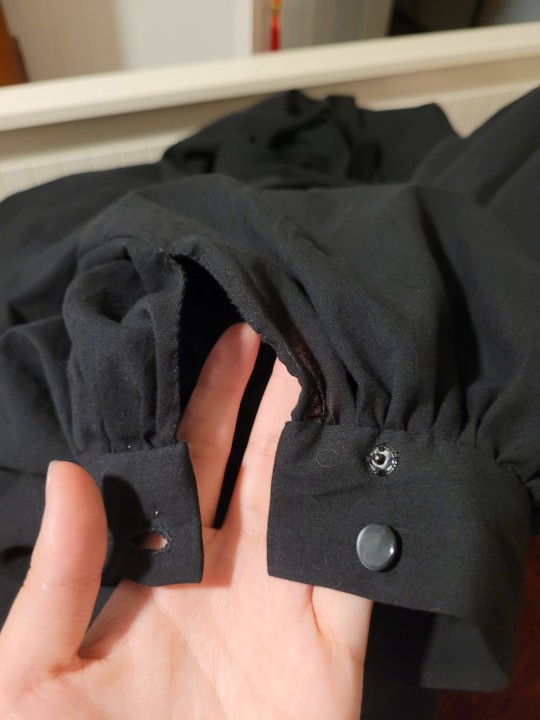
Also put one on the collar so i could try it on. I think the placket at the back of the blouse is a little ugly and larger than ive seen in extant garments but i forgot to adjust the pattern for my broad shoulders and need the extra width for comfort.
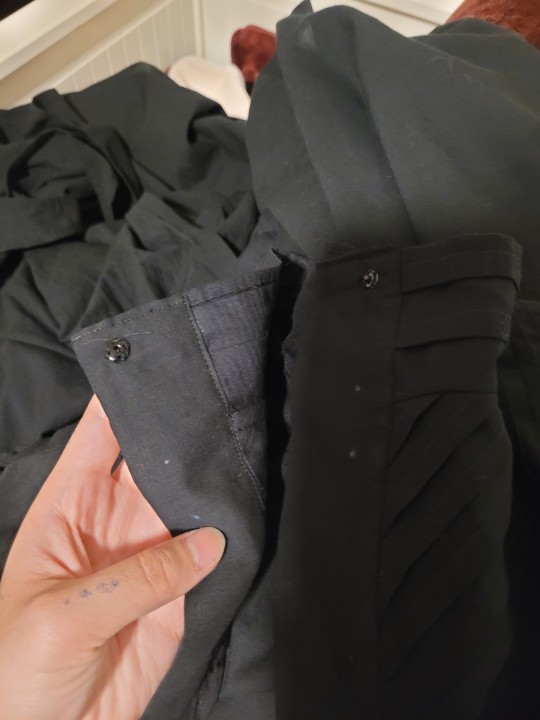
I tried on the blouse and skirt together:
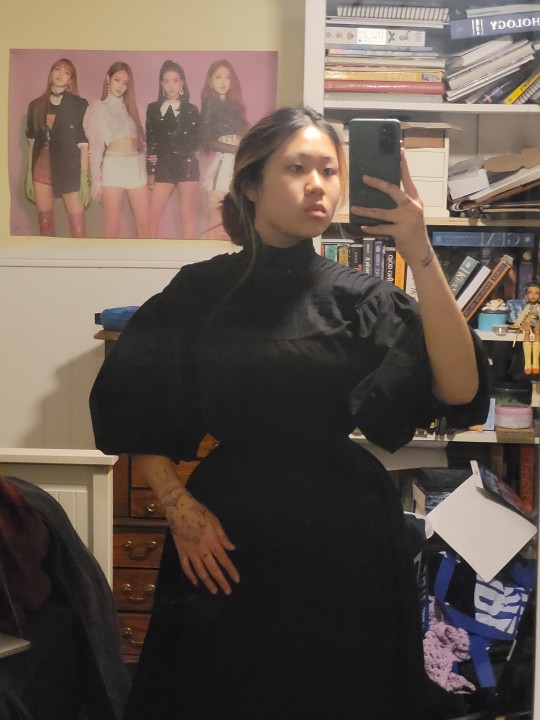
I may need to loosen the waistband of the skirt, the corset is a bit bulkier than i thought itd be. Also the blouse is just stuffed into the skirt and currently only has one closure on at the collar so it looks a little bit disproportionate. The belt/sash will help smooth everything out so i dont look like im drowning in voile.
I might go without the bustle pad during the final shoot because i think it gives too much volume in the waist/hip area for edwardian tastes. Its from an 1890s pattern, so the silhouette is a bit out of date. I should probably try the skirt on without the pad before extending the waistband though.
Im pretty happy with how the sleeves turned out! I have some vintage nottingham lace i bought on etsy from penelope textiles that i was going to add to another project. I think ill sew some different laces together and add it to the cuffs to elongate them a bit. Since this dress is supposed to be from roughly 1905, i want the sleeves to look as they wouldve in that time. The photos ive seen mostly feature large ruffles at the ends of elbow-length sleeves but i dont think ill be likely to wear ruffles very often. Ive also seen tighter cuffs that extend from the elbow to mid-forearm or from the elbow to wrist. I think the elbow-length sleeves are a feature of afternoon dresses but i could be wrong. Maybe that was just day dresses? Not sure.
Im also not sure if i want to get gloves/a hat/parasol for this project. On one hand, it would look really cool for the video. On the other hand, it sounds quite expensive and i doubt ill wear it again. I dont want to buy things i wont use and create waste, theres enough of that in fashion. I have a pink 1900s parasol that i might cover with black fabric, but idk.
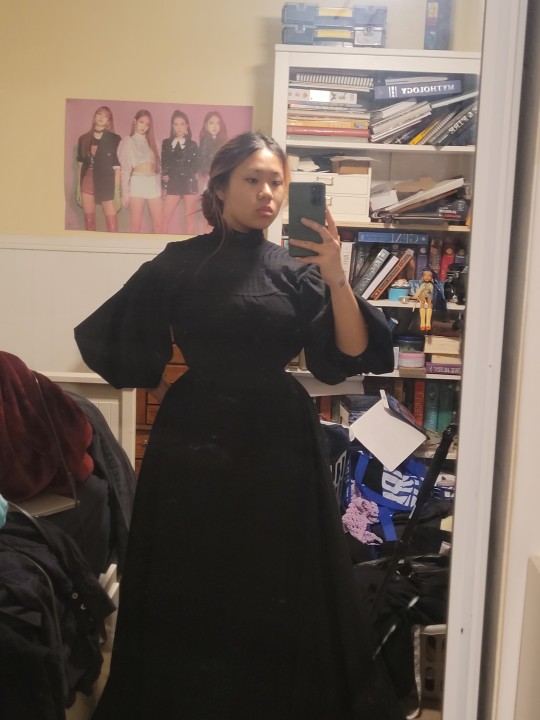
There isnt much left to do! Im gonna make a list here so i have it written somewhere:
-sew snaps onto blouse
-finish blouse hem
-attatch lace cuffs
-press pleats on sash/belt
-order synthetic whalebones
-add bones, hook/bars to belt
This is just the sewing tasks though, i need to edit the video clips and record audio. I have no idea how to do any of this. I just downloaded davinci video editor so hopefully i can figure it out. The only experience i have with video making/editing was in 3rd grade on ipads on the imovie app. Ive just been binge watching bernadette banner videos bcs i love her video style.
Any tips/feedback are much appreciated! ♡
Date: 4/22/24
#edwardian fashion#1900s#early 1900s#edwardian era#edwardian#victorian mourning#victorian dress#victorian era#victorian fashion#fashion history#historical costuming#historical dress#historical fashion
98 notes
·
View notes
Text

Trade Card for Wheeler & Wilson's New High-Arm Family Sewing Machine ca 1900
15 notes
·
View notes
Text

At the request of @enjoji101さん, let's take a look at the lives of Sims in the world they are currently playing in.
This is "Town Sleepy Hollow" by @bast-simsさん.
※When you download the world, MH objects are also included, so you don't need to have MH.
This time's lighting mod "BrntWafflesMidnightDreamLightingMod2.0RHwater"@brntwafflesさん
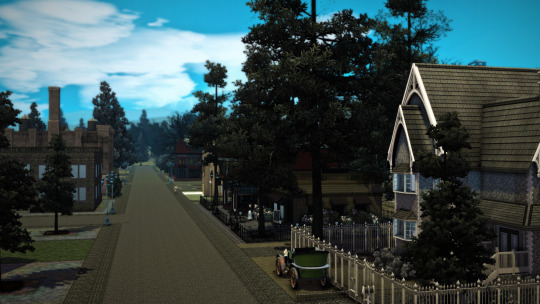
At first, like MH, I was playing with a "steampunk" theme, but before I knew it, it had become "dark victorian."
Late 1890s to around 1900. The setting is Victorian, close to Edwardian.
It's a little weird that there are cars, since cars were popular after 1900, but it's a game, so don't worry about it. Of course there are horse-drawn carriages.

↑Custom music list(Ah, the image is quite small. sorry.)
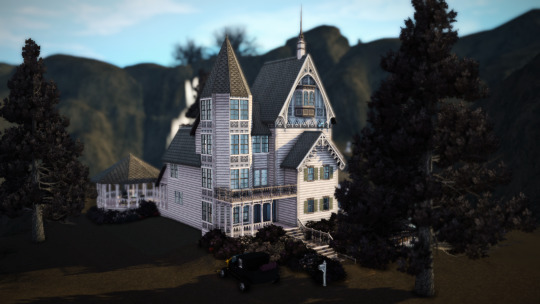
The residence is the previously shared "Gloomy Abode" which has been slightly renovated.(The existing housing here has been moved nearby and is now inhabited by grim reapers.)
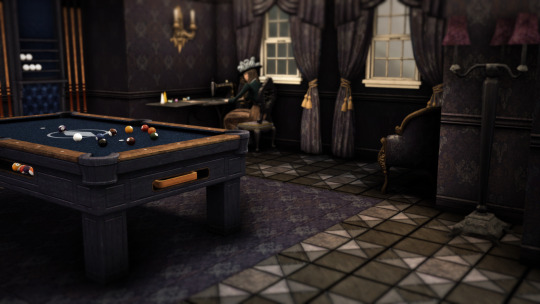


Since we don't have young children, we renovated the baby room with a billiard table and a sewing machine(Thanks to @greenplumbboblover for this great CC.). The sewing machine in particular has become a good pastime for Sims.


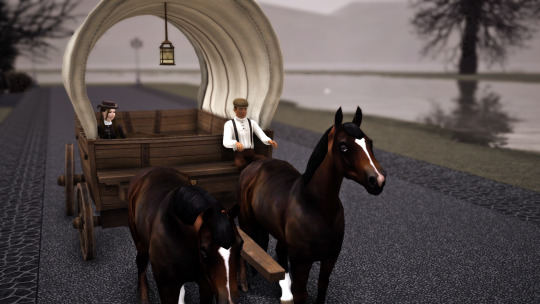
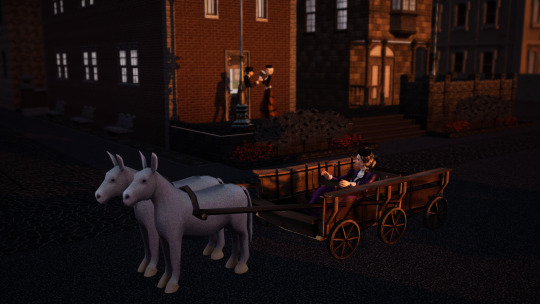
various vehicles.
Vintage Motor Car⇒Fresh Prince Creations Schoolbus Default and Driveable Wagon&Car Default Replacements⇒@danjaleyさん
For clothes, check out @joojconvertsさん, AllAboutStyle, @deniisu-simsさん, and @lunenoreさん. thanks so much.


This time, I did a makeover on Sarah Holden and turned her into an inorganic beauty like a doll.
Ah, this post is getting long, so I'll continue it next time.
The long vacation ends today. I'm a little depressed as I think my busy days are about to begin.
☆I can’t write it all down, but I’m grateful to the many CC creators.☆
Thank you for always reading my posts!
Bye for now!
#the sims3#sims3#ts3#ts3 screenshots#ts3 simmer#sims 3 gameplay#sims 3 simblr#Town Sleepy Hollow#bast-sims
67 notes
·
View notes